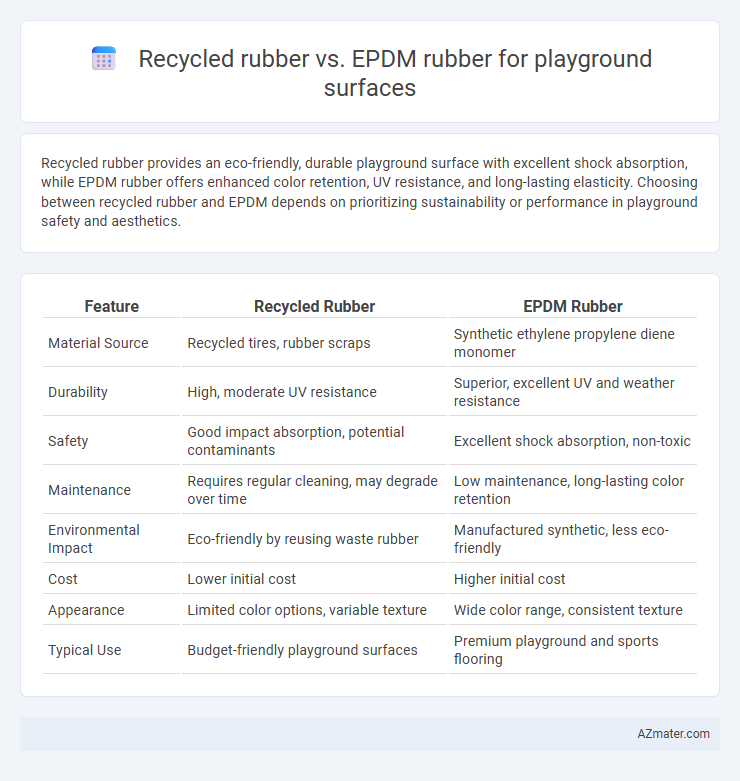Recycled rubber provides an eco-friendly, durable playground surface with excellent shock absorption, while EPDM rubber offers enhanced color retention, UV resistance, and long-lasting elasticity. Choosing between recycled rubber and EPDM depends on prioritizing sustainability or performance in playground safety and aesthetics.
Table of Comparison
| Feature | Recycled Rubber | EPDM Rubber |
|---|---|---|
| Material Source | Recycled tires, rubber scraps | Synthetic ethylene propylene diene monomer |
| Durability | High, moderate UV resistance | Superior, excellent UV and weather resistance |
| Safety | Good impact absorption, potential contaminants | Excellent shock absorption, non-toxic |
| Maintenance | Requires regular cleaning, may degrade over time | Low maintenance, long-lasting color retention |
| Environmental Impact | Eco-friendly by reusing waste rubber | Manufactured synthetic, less eco-friendly |
| Cost | Lower initial cost | Higher initial cost |
| Appearance | Limited color options, variable texture | Wide color range, consistent texture |
| Typical Use | Budget-friendly playground surfaces | Premium playground and sports flooring |
Introduction to Playground Surfacing Materials
Recycled rubber and EPDM rubber are two common materials used in playground surfacing, offering distinct benefits in safety, durability, and environmental impact. Recycled rubber, often sourced from repurposed tires, provides excellent shock absorption and cost-effectiveness, while EPDM rubber is known for its vibrant colors, UV resistance, and long-lasting performance. Choosing between these materials depends on factors such as budget, design flexibility, and maintenance requirements for safe and resilient playground surfaces.
What is Recycled Rubber?
Recycled rubber is made from repurposed scrap tires and other rubber products, offering an eco-friendly material for playground surfaces. It provides excellent shock absorption, durability, and slip resistance, making it ideal for safety in play areas. Compared to EPDM rubber, recycled rubber is typically more affordable and supports waste reduction by diverting tires from landfills.
Understanding EPDM Rubber
EPDM rubber, made from ethylene propylene diene monomer, offers superior durability, UV resistance, and weather stability compared to recycled rubber, making it ideal for playground surfaces exposed to various climates. Its consistent texture and vibrant color retention enhance both safety and aesthetic appeal, while its non-toxic nature ensures a child-friendly environment. EPDM rubber's flexibility and shock absorption capabilities provide excellent impact protection, reducing injury risks on playgrounds.
Safety Performance: Recycled Rubber vs EPDM
Recycled rubber offers excellent shock absorption and impact attenuation, making it highly effective for playground safety by reducing the risk of injuries from falls. EPDM rubber also provides superior slip resistance and consistent cushioning, enhancing child safety with its durable, weather-resistant properties. Both materials meet ASTM safety standards, but recycled rubber's superior energy restitution and EPDM's low maintenance make them preferred choices for different safety performance needs.
Durability and Longevity Comparison
Recycled rubber playground surfaces exhibit strong durability with excellent resistance to impact, abrasion, and weathering, making them ideal for heavy foot traffic and varied climates. EPDM rubber offers superior UV resistance and color retention, maintaining its structural integrity and vibrant appearance for over a decade under intense sunlight exposure. While both materials provide long-lasting safety and comfort, EPDM typically delivers enhanced longevity due to its advanced polymer composition and resilience against environmental degradation.
Environmental Impact of Each Material
Recycled rubber playground surfaces significantly reduce landfill waste by repurposing discarded tires, lowering environmental pollution and conserving natural resources. EPDM rubber, while durable and non-toxic, is produced from synthetic polymers derived from petroleum, contributing to higher carbon emissions during manufacturing. Choosing recycled rubber promotes circular economy principles and offers a more eco-friendly solution by minimizing resource extraction and waste generation.
Installation and Maintenance Differences
Recycled rubber playground surfaces offer easier installation with flexible pour-in-place or tile options, requiring less specialized equipment compared to EPDM rubber, which demands precise mixing and curing processes for optimal performance. Maintenance for recycled rubber is lower, involving simple cleaning and occasional debris removal, whereas EPDM surfaces may need periodic resurfacing and repair to preserve color and elasticity. The durability of EPDM rubber ensures longer-lasting aesthetics, but recycled rubber provides a cost-effective, quick-installation alternative with straightforward upkeep.
Cost Analysis: Upfront and Long-Term
Recycled rubber playground surfaces typically offer lower upfront costs compared to EPDM rubber, making them a budget-friendly option for initial installation. EPDM rubber, while more expensive initially due to its superior durability and UV resistance, tends to have lower maintenance and replacement costs over time. Long-term cost analysis favors EPDM rubber as it provides enhanced longevity and resilience, reducing the frequency of repairs and replacements.
Design and Aesthetic Flexibility
Recycled rubber offers limited color options and surface textures, often resulting in a more utilitarian appearance for playground surfaces. EPDM rubber provides superior design and aesthetic flexibility, allowing for vibrant colors, custom patterns, and detailed graphics that enhance play environments and stimulate creativity. This versatility makes EPDM the preferred choice for designers seeking visually appealing and customizable playground flooring.
Which is Better for Playgrounds: Verdict
Recycled rubber and EPDM rubber both offer durable, shock-absorbing surfaces ideal for playground safety, but EPDM provides superior color retention, UV resistance, and consistent texture, enhancing long-term aesthetic appeal. Recycled rubber is more cost-effective and environmentally friendly, often made from repurposed tires, but may deteriorate faster and release stronger odors. For playgrounds prioritizing safety, appearance, and longevity, EPDM rubber generally delivers better performance and user satisfaction.

Infographic: Recycled rubber vs EPDM rubber for Playground surface
 azmater.com
azmater.com